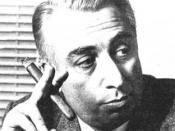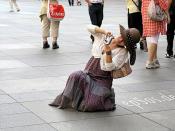The representation of the sixties' cultural revolution through photography
Before exploring what made photography such an important tool for the sixties Cultural Revolution, I feel it necessary to define what is meant by the term 'cultural revolution.' The term had in 1965 been used to describe the 'policies initiated in China by Mao Tse - Tsung' who believed 'that you could only have complete revolution if you not only removed the bourgeoisie from power, but destroyed all vestiges of bourgeois ideology.' This is not the kind of revolution that occurred in the West. Here, we are looking for changes in sexual behaviors, in ideas and values. There are unfortunately too many areas of change to fully discuss here so I have chosen one area, illustrated by a photograph, which I feel contributed towards the 'cultural revolution' that I believe took place during the sixties. This area is the transformations in protest with its issue of the freedom of speech.
Photography is a technological invention that has become the most universal means of communication and artistic expression that the world has known. It overcomes the differences of language. It can be specific and realistic, where music and related media can only be abstracted or general. Photography becomes then a tool conveying various meanings about the subject matter being photographed. Therefore, we can discuss the cultural revolution of the sixties through photography.
One key photographer illustrating this period is Fank Habicht. His black and white photographs focus on the sixties western cultural revolution. Born in Hamburg, he spent his time during the sixties in London, Paris, Berlin and New-York while exhibiting worldwide. His photography has features in many magazines and journals, including Die Welt, US Camera, Esquire, Twen and The Guardian. His work essentially shows a view of an exhilarating period,


